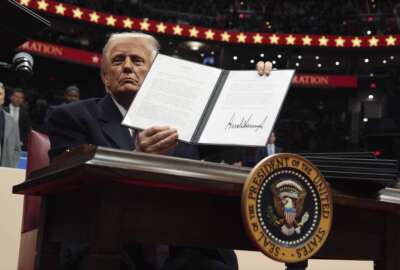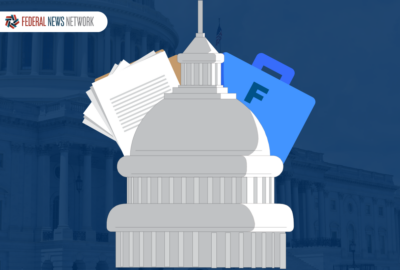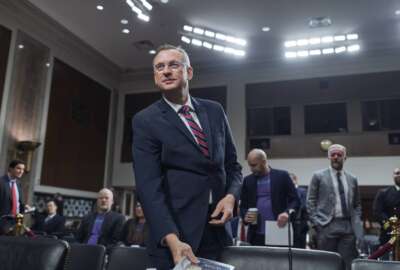What? A new government agency for homeowner insurance?
Bad weather has caused increasing real estate damage and insurance losses. My next guest proposes a federal solution to a problem.
Bad weather has caused increasing real estate damage and insurance losses. My next guest proposes a federal solution to a problem he thinks the property insurance market isn’t equipped to handle. He’s a former chief risk officer at CitiGroup… now a professor at the University of Maryland. Cliff Rossi joins the Federal Drive with Tom Temin.
Interview transcript:
Tom Temin
Just give us an outline of the problem. We see this in Florida, where casualty insurance is going through the roof and so on. And because losses seem to be rising because of weather and climate.Cliff Rossi
That’s exactly right. Whether you call it extreme weather events or climate change. Just to put some numbers around this, in 2023 property and casualty losses, catastrophic losses, were about $65 billion alone. And NOAA in 2023 also tracked 28 separate storms that caused more than a billion dollars in damages. So that paints a picture here, in addition to the fact that we as homeowners, when we pay our property, not just our property taxes, but our hazard insurance, our homeowners insurance policies have gone up 27% between 2021 and 2024. So if you can get insurance, it’s very expensive, and in many places of the country, we’re finding that large insurance companies are pulling out all together, like in California and Florida, as a result of either wildfires that have happened and raging in those states or flooding in other states. So it’s a huge issue, and I think it’s the next crisis that we’re going to see in housing within the next five to 10 years, easily.Tom Temin
We’ve even seen in Florida where people feel they have the means to self insure, which means no insurance, and you just pay for whatever happens to your house.Cliff Rossi
Exactly. And that’s a scary proposition alone. And if you can’t get insurance, and you want it, then in states like Florida and in California, you may be put on to a state run insurance program. And those have been not too stable over the last several years either. So many problems here, and whether you call it a market failure, whether you call it private problem for all of us as individuals, I think we need to realize that the current structure of our insurance markets and our housing finance system are not able to handle this change that we’re seeing coming with either extreme weather events, or, as we call it, climate change.Tom Temin
OK. And you’ve written a proposal that would involve the federal government, but not necessarily create a new federal agency to kind of be a reinsurer or insurer. Tell us about your plan.Cliff Rossi
We would be creating a new federally chartered entity, similar to Fannie and Freddie, but focus exclusively on taking the catastrophic risk associated with natural hazards. And it would be charter, just like a Fannie and Freddie, it would not be a federal agency of the government. And in fact, the first several years of this new chartered entity would basically be working to take the National Flood Insurance Program that is under FEMA today and move it under this new entity. And we say, why would we do that? Isn’t that just a shell game, and we’re moving boxes around? And the answer to that is no. Fannie and Freddie, whether you like them or you hate them, the one thing that we’ve realized in our housing finance system is that they do something very well that other private lenders cannot do. They can take that risk, that credit risk on the back end, much better than, let’s say, my old institution, Citigroup, or another institution like that.And so what we have here today is a situation where, as I just said earlier, where if insurance companies are either unable to get 50 different state insurance commissions to sign off on their new rates, because they’re incurring losses that they’ve had from the last year, and they’re seeing higher rebuilding costs. They’re seeing higher reinsurance costs that they have to pay in order to kind of insure themselves to some extent. What are they going to do? They’re going to either kind of recede from those markets, or they’re going to then, if they can, start to increase rates, as we’re seeing for homeowners. Instead this new entity, what it would do, is it would act much like today’s National Flood Insurance Program, but on steroids. It wouldn’t just cater to flood insurance if you are in an area that has wildfire risk or drought risk or riverine flooding. So you don’t have to even live on the coast. Any of these different hazards that face us as homeowners would be covered under a national hazard insurance policy. Each homeowner would have basically two policies. They’d have a standard homeowners policy, like they do today, with the exception that it wouldn’t today cover things like wind and those kinds of perils. So with tornadoes, sometimes you can get as riders on your policies. You wouldn’t have any of that today, you would have a standard policy for things like trip and fall, theft, fire, etc. That would be a standard policy that today’s insurance companies would continue to write going forward.
Tom Temin
We’re speaking with Dr. Cliff Rossi. He’s a professor at the. University of Maryland, business school, and also an expert insurance and reinsurance and risk management. Well, how would this national policy then work?Cliff Rossi
The National hazard policy would be underwritten by this Federal National Housing Insurance, National Hazard Insurance Corporation, rather. And what would happen in that case is that insurance companies would act as brokers, as they do for flood insurance today, they would get those policy holders set up, and then what would happen is that they would sell those over to this new Federal National Housing insurance, Natural Hazard Insurance Corporation. The point of that is, right today, the insurance companies and even the reinsurance companies simply are faced with a lot of uncertainty, in terms of how do they price for this risk and all those things. And the magic that would happen that’s very different than what we have today in the National Flood Insurance Program is that right today, I think the NFIP is $20 billion in the hole to the federal government based on mispriced flood insurance programs over the past decades. We would have folks that actually are experts, both in understanding climate as well as the pricing actuaries. And those folks would then create what I’m calling climate risk transfer securities. These would be securities that would bundle up all of these policies and sell them out to the capital markets.Tom Temin
And who would you expect to actually acquire them?Cliff Rossi
Who would be the primary takers of these? Well, it would be insurance companies that would love to take a first loss piece that’s a little bit clear for them in terms of the losses that they would sustain, and reinsurance companies that would like to be able to have more certainty about what stakes they’re taking in terms of these losses over time. So I think it works out for the insurance companies might not first glance say, well, you’re taking business away from us. I’d say absolutely not. In fact, if anything, you’re able to come right back in with more certainty around the types of risk that you want to take in your own portfolios.Tom Temin
And so what effect would this have? You mentioned it would take one of the big programs out of FEMA. What would the federal role actually be in this setup?Cliff Rossi
So it would be overseen by the federal insurance office that is in existence already today. They would be there overseer, if you will, in terms of regulatory oversight. But in terms of the impact on the housing finance system, on Fannie and Freddie, which, by way, are sitting on top of trillions of dollars worth of mortgages, and they’re concerned too today about this gap that we’re finding, increasing gap around homeowners policies. And what it would do is it would provide certainty. Everybody would have access to an affordable hazard insurance policy, whether you live in a state let’s say up in Vermont, where you may not be as exposed to natural hazards, or whether you live in California, you would have a policy. It would be a fairly priced policy. And in many instances, it would be priced lower than what you have today.Tom Temin
So it’s a really redistribution of shared risk. You might say.Cliff Rossi
That is correct, exactly. That’s exactly what this is.Tom Temin
And what action would be required, do you think, in your experience, to create this? Sounds like this would take an act of Congress.Cliff Rossi
It would take an act of Congress. So it’s not a band aid fix, but it’s a fix that I think we need to start on now. Because the current solutions are very, very negligible, let’s just say. So it would take an act of Congress. And it would take a capitalization of this new entity on order of somewhere, I estimate, somewhere around $200 billion to stand this entity up. That is to have the capital support on the back end, the kind of losses that might come at it in the future. So not an insignificant number.Tom Temin
Any interest that you’ve had, or any members of Congress you feel could be amenable to thinking about this.Cliff Rossi
Yeah. So I presented this actually, at a fairly large conference, housing finance conference on climate change earlier this year, and surprisingly, it was met with a lot of positive interest from people that I would never have thought in a million years would have thought that might be a solution, on both sides, right of the aisle. So I do think it has great potential, notwithstanding some of the issues that we’re talking about, how to get this off the ground. We’ve got so many issues going on in kind in Congress today. Trying to get agreement on anything is tough, but this is one of those things that I think all of us can get behind and say, whatever you call it, we are facing an existential crisis in the housing financial system because of this.Tom Temin
And by the way, what would be left to be covered by the standard leftover or what’s left of insurance policies you buy from the John Hancocks, etc of the world.Cliff Rossi
Yeah. So again, they would be there to provide your standard homeowners policy, as you have today. You wouldn’t have to worry in that you get a letter in the mail that policy isn’t being renewed. You would still have that. And that policy, that standard homeowners policy, because it wouldn’t have this natural hazard component that it does today, would actually be priced better than what it is today as well. So all in you’re going to have two policies, one that’s a standard one that’s a natural hazard policy. And together, they should be no more expensive than they are today. And with this entity, should be actually less expensive.
Copyright © 2025 Federal News Network. All rights reserved. This website is not intended for users located within the European Economic Area.
Tom Temin is host of the Federal Drive and has been providing insight on federal technology and management issues for more than 30 years.
Follow @tteminWFED






